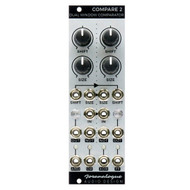Joranalogue - Compare 2
by Ellison Wolf
Belgium based Joranalogue has a knack for making immensely useful and versatile modules and Compare 2, their dual window comparator module is yet another well designed, interesting machine.
If you’re not familiar with window comparators, it’s probably because they aren’t too common in the modular world. A normal comparator uses one signal level as an activator, and when the signal hits and/or goes higher than a selected threshold, the comparator is activated. A window comparator is similar, but adds another signal level, as a sort of ceiling [or floor, depending on the settings] to define the ‘window’, that the comparator is active for. It’s helpful to think of Compare 2 as a shifting gate, both in terms of size and when/where it will operate as you can move the window around to change when it’s activated, and you can also change the size of the window for what voltage/s will activate it.
Each of the two Compare 2’s windows are shaped by the size and shift parameters, which are both controllable by knobs or CV. The “Size” is the span of the window—where it will activate—and the shift offsets the window’s center and has a range from -5 to +5v, with 0 being in the center. The Shift and Size CVs are normalled from the left channel to the right, so that you can modulate both comparators with only two inputs, but by patching into the right side’s CV ins, you get two fully independent comparators. Three color LEDs show the status of each comparator; blue for when the input voltage is below the window, red for above, white when inside the window, and off if the window size is negative and the signal is in the negative window, and is an efficient way to signify what’s going on, so long as you can remember what each color means.
Since Compare 2 has two sides, you can use them in stereo, creating some dynamic stereo shifts. One of the weirdest things I did in this way was to use the output of the second section to pan the output of the first in my mixer. Another, is when I multed a single LFO and patched into the SHIFT and SIZE CVs on both sections. I needed a little more variation, so I patched a different division of the same LFO into the SHIFT CV in the second section, and that brought me a pretty cool beat to work with.
I really felt Compare 2 shined the most when I used both sections in tandem, playing off one another. Processing a drum track through it was an interesting experience, and really highlighted the absolutely insane rhythmic possibilities that Compare can offer up, especially when using the logic outs at the bottom of the module. Since the modulation coming out of Compare 2 is only in the land of the positive, that means that there can be moments of silence depending on how everything is set up in terms of the Size and Shift knob settings, and I rather liked this effect quite a bit. I had the input normalized, but the output of channel one going straight to my mixer in my left channel while output two went through the Joranalogue Filter 8 [reviewed in issue #2] and then on to the Frequency Central Stasis Leak for some reverb before going to the mixer, with the AND output of Compare 2 triggering the Density of the reverb, making for some really awesome bass rhythm that would stop in the left channel and pick up on the right before going silent. Basically, with one sound source as the input for channel one [and since it’s normalled, it’s also the input for channel 2], something as simple as a saw wave can be utilized for almost an entire dance track when modulating the SIZE and SHIFT on both channels. It’s quite impressive.
As I mentioned earlier, Joranalogue modules are really versatile, and one of the reasons has to do with how their modules have a lot of interesting extra inputs/outputs/twists and turns at the bottom that allow for some extra flavor. Compare 2 has some really cool logic functions that sum the comparator outputs resulting in AND, OR, XOR and flip-flop outputs. It’s pretty interesting to see the logic LEDs light up to see when, and how they trigger when the windows are activated. Things get really interesting when using a random CV to trigger the Contour 2, and patching various logic outputs to trigger various aspects of a drum voice, pinging a filter, or using PWM to get some crazy rhythms while still being copacetic with each other.
Before I sign off on this review, let me mention a few other things about Joranalogue’s modules. The faceplates are all familial and have a very scientific, scholastic look to them, and even the power header on the back, recessed into the bottom layer PCB is an interesting, well thought out touch, and tells of the great attention to detail throughout the line. I remember seeing a few social media posts of Joran and his fully Joranalogue rig, with its multiple Filter 8’s, Generate 3 prototypes, and the rest of the line, and thinking that schools that teach sound synthesis, and the fundamentals [and possibilities] of, would do well to use a rig made up solely of Joranalogue modules for that purpose. The basics are all there, and the way that they can expound upon those basics are, and can be very educational and instructional, and most importantly, excellent for manipulating sound in musical or non-traditionally musical ways. They aren’t the most eye catching modules out there, but they might be the most um...brain [?] catching ones.
8 HP +12V: 20mA -12V: 15mA
Price: $210


